Fuel Cell Research: FCV is Expected to Boom over the Next Decade
In our recent report Global and China Fuel Cell Industry Report, 2020, we analyze the advances and tendencies of fuel cell industry in China and beyond.
Hydrogen, as an efficient clean energy of strategic importance, is drawing widespread attention, and it is in the upswing. Hydrogen fuel cell which is efficient to convert fuel energy with low noise and zero emission, finds broad application in automobiles, ships and trains as well as stationary power plants.
Fuel cell has been such a concern of governments and companies worldwide that have lavished ever more on research and development, demonstration and commercial application. It is noteworthy that hydrogen and fuel cell have already been commercialized in some sectors, among which automobile makes the best of them. Through the lens of life cycle of automobile industry, ICE vehicle has matured, and traditional automakers, however, have quickened their pace of transformation weighed by the thriving new energy vehicle industry, and some leading automakers has been sparing no efforts in the development and application of hydrogen fuel cell vehicles.
Status Quo and Planning of Global Fuel Cell Vehicle Industry
Globally, major countries are scrambling to mobilize enormous resources for the development of hydrogen fuel cell vehicles, hoping to take the lead in future competition in energy. For the moment, Japan, South Korea and China are the top three hefty investors in the fuel cell vehicle industry. The typical automakers, Toyota and Hyundai, stay ahead of their peers in production of fuel cell passenger cars, hydrogen buses and logistics vehicles. The discouragement from the Trump Administration in recent two years has hindered development of fuel cell vehicle in the US, but California as the biggest single market of fuel cell passenger cars is still a colossus in the whole industry. Europe has developed fuel cells from an early start, with traditional automakers like Mercedes-Benz and Tier1 suppliers such as Bosch all having forayed into the fuel cell vehicle field.
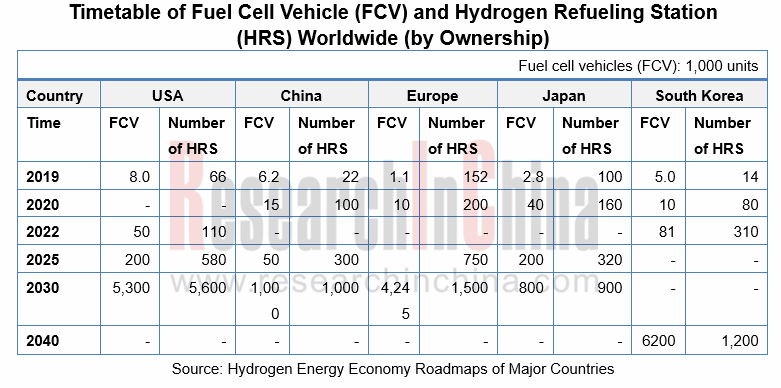
China is Close to Its Leading Peers in Fuel Cell System and Engine
Fuel cell engine system is comprised of fuel cell engine, voltage converter (DC/DC) and vehicle hydrogen system, of which fuel cell engine packs such core components as stack, engine controller, hydrogen supply system and air supply system.
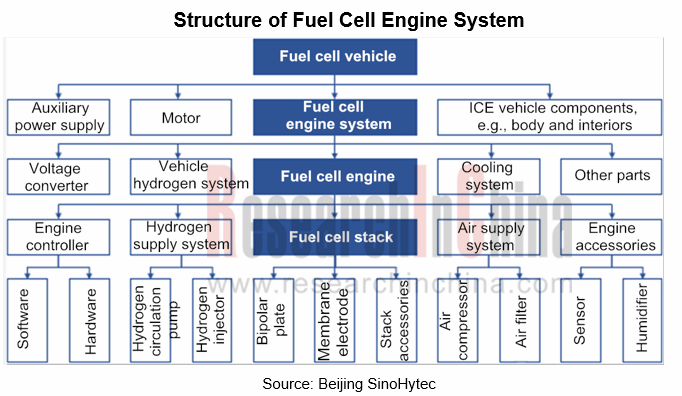
At present, China has come near to global leaders in fuel cell system and engine. In terms of fuel cell engine technology, fuel cell vehicles have been mature enough to be commercialized, with service life of fuel cells for commercial vehicles longer than 20,000 hours, meeting basic needs of vehicles for running; China’s hydrogen fuel cell engine system leads the world in several parameters, e.g., power density. Notably, on July 21, 2020, VISH-130A, a fuel cell engine of Wuhan HydraV Fuel Cell Technologies Co., Ltd. (under Vision Group), passed the certification of China Automotive Technology and Research Center Co., Ltd. (CATARC) and China National Accreditation Service for Conformity Assessment (CNAS), with stack power up to 145kW and engine system net output of 130kW. VISH-130A boasts the maximum power among hydrogen fuel cell engines having been certified by the CNAS so far.
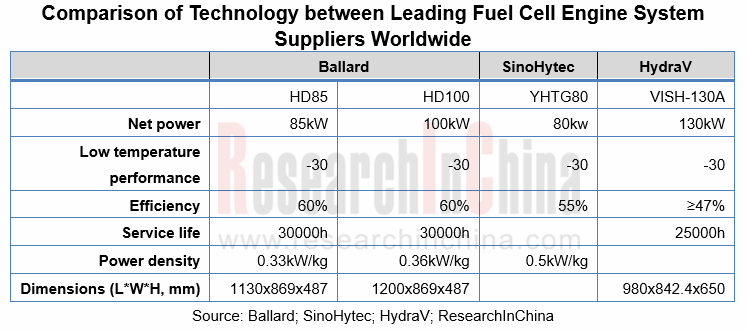
China Remains Weak in Core Components and Materials of Fuel Cell with Heavy Dependence on the Imported
Although with the world’s advanced fuel cell engine technology, China still has weak foundation in supply chain of fuel cell engine system, having yet to build a mature components supply system. The country still needs to import most of core components and key materials including catalyst, proton exchange membrane and carbon paper, and falls far behind its foreign counterparts in technologies from membrane electrode and bipolar plate to air compressor and hydrogen circulation pump. Chinese companies still need breakthroughs in basic materials, core technologies and key components, especially in commercialization of key parts like membrane electrode.
Fuel cell catalyst: it should perform very well in properties such as activity, stability and durability and could develop into a commercial product mature enough to be mass-produced only after long-term application. Now in China, catalyst verified abroad is the first option, mainly low platinum loading catalyst with high quality and high activity; homemade catalyst test is under way at the same time.
In the global fuel cell catalyst market, Toyota uses subsidiaries’ catalyst for fuel cell vehicles; Hyundai chooses fuel cell catalyst of a local producer (acquired by Umicore) in South Korea; Honda’s catalyst for fuel cell vehicles is supplied by TANAKA Precious Metals; Chinese fuel cell vehicles use catalyst from TANAKA Precious Metals and Johnson Matthey.
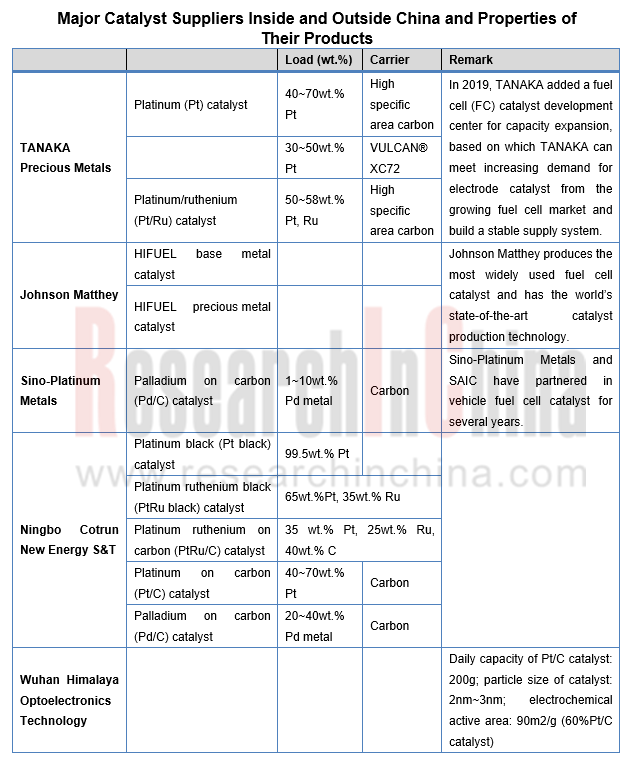
Proton exchange membrane (PEM) is the core component of a proton exchange membrane fuel cell, accounting for 30% of the entire fuel cell stack cost; and its quality determines the lifespan of the fuel cell. PEM basically transmits protons, ensure the passage of protons, and intercept electrons, hydrogen molecules, water molecules, etc., guaranteeing the performance and service life of the stack.
Concerning proton conductivity or stability, perfluorosulfuric acid membrane is the best option for the current automotive proton exchange membrane. Dongyue Group is the sole Chinese enterprise that has realized the industrialization of perfluorinated ion exchange resin, perfluorosulfonic acid proton membrane and ETFE and that can compete with foreign companies Gore and Chemours in proton exchange membrane.
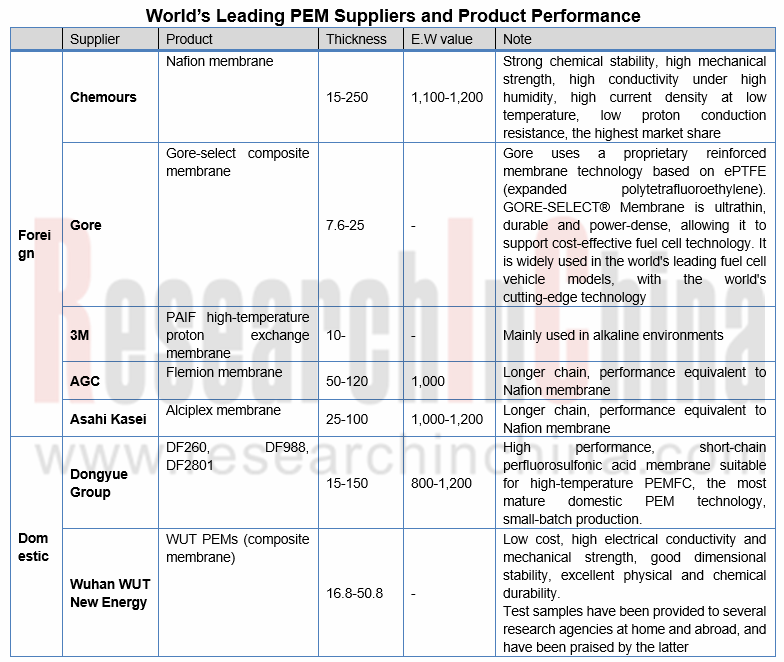
Moreover, fuel cell carbon paper/powder is totally dependent on imports. Carbon powder is cheap and may well be completely imported, but from a technical point of view, the inadequate technical research on carbon materials and the weak foundation will have implications for entire research equipment of the fuel cell system in China.
In recent years, there have emerged a number of suppliers of core fuel cell components in China, but they are still heavily reliant on exports, and their technical level of core components needs improving.
China's fuel cell vehicle promotion: commercial vehicles go first
In the promotion of fuel cell vehicles in China, fuel cell commercial vehicles take precedence over the rest, due to a combination of factors such as fuel cell technology, cost, and infrastructure of hydrogen refueling stations. 100 models of fuel cell commercial vehicles are among the fuel cell vehicles listed in the Catalog of Recommended Road Vehicles released by the Ministry of Industry and Information Technology of China in 2019 but no fuel cell passenger car is on the list. Over the past five years, only SAIC, Chery and BAIC have showed fuel cell passenger cars, most of which were still prototypes, except a SAIC Roewe 750 car that was licensed in Weifang city of Shandong in April 2020. According to fuel cell vehicle promotion programs across China, buses, logistics vehicles, and special vehicles prevail but passenger cars are not taken seriously.
As concerns development route of fuel cell vehicles, foreign countries adopt the strategy of developing commercial vehicles and passenger cars in sync while China prioritizes commercial vehicles over passenger cars. In the next three or five years, fuel cell systems will be massively used in commercial heavy-duty and logistics vehicles in China, and passenger car will be an obscure corner still.
Product support programs of key suppliers of fuel cell components mirror China’s strategy of “commercial vehicles first, passenger car second”. SinoHytec's flagship product, hydrogen fuel cell engine system, targets commercial vehicle manufacturers who are early entrants in the fuel cell vehicle market, including Shenlong Bus, Beiqi Foton, Yutong Bus, Zhongtong Bus and Geely Commercial Vehicle.
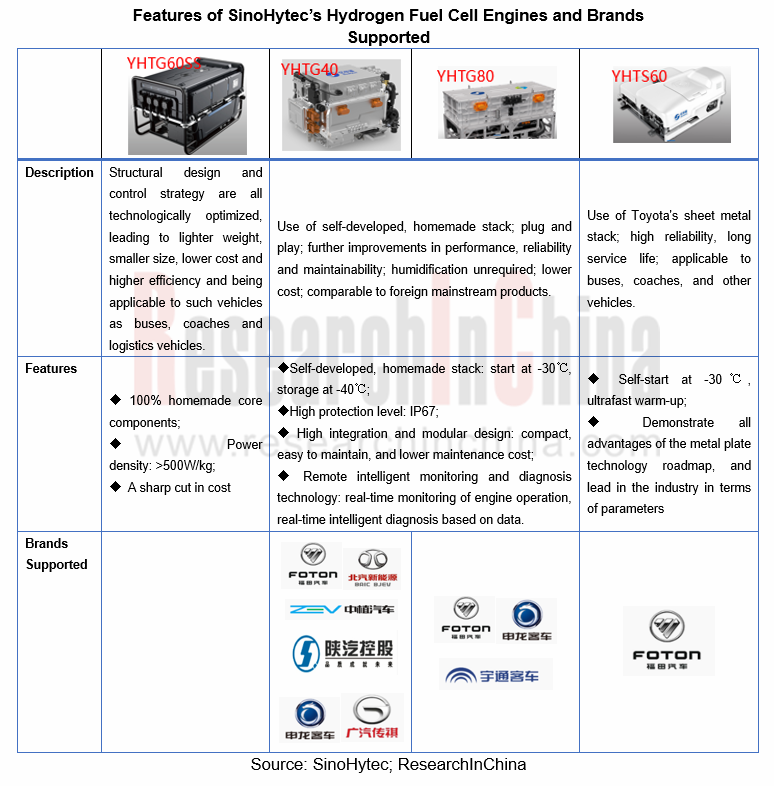
Global and China Leading Tier1 Suppliers’ Intelligent Cockpit Business Research Report, 2022 (II)
Tier1 Intelligent Cockpit Research: The mass production of innovative cockpits gathers pace, and penetration of new technologies is on a rapid riseGlobal OEMs and Tier 1 suppliers are racing for the i...
Global and China Leading Tier1 Suppliers’ Intelligent Cockpit Business Research Report, 2022 (I)
Tier1 Intelligent Cockpit Research: The mass production of innovative cockpits gathers pace, and penetration of new technologies is on a rapid riseGlobal OEMs and Tier 1 suppliers are racing for the i...
China Commercial Vehicle Intelligent Cockpit Industry Report 2021
Research on Intelligent Cockpits of Commercial Vehicles: Heading for Large Screens, Voice Interaction, Entertainment and Life
Following AD/ADAS functions, the intelligent configuration of the cockpit...
Automotive Ultra Wide Band (UWB) Industry Report, 2022
UWB got initially utilized in the military field, and began to be commercially applied after the release of criteria for UWB commercialization in 2002. In 2019, Car Connectivity Consortium (CCC) liste...
China Automotive Distribution and Aftermarket Industry Report, 2022-2027
Since the introduction of 4S store model into China at the end of 20th century, China's authorized dealer system has gradually developed from a single-store-based mode to a group-based mode, and from ...
Global and China Skateboard Chassis Industry Report, 2021-2022
Research into skateboard chassis: where to sell, how to sell and to whom it is sold
Rivian, a new carmaker based on skateboard chassis, is quite popular in the market and becomes the focus of the aut...
Emerging Automakers Strategy Research Report, 2022--NIO
Research on emerging carmaking strategies: no new cars in 2021, 3 new cars in 2022, can NIO make its renaissance?
The delivery of ET7 is imminent, and the sluggish sales situation is expected to fade...
Automotive and 5G Industry Integration Development Report, 2022
Research on integration of vehicle and 5G: OEMs rush into mass production of 5G models whose sales may reach 3.68 million units in 2025
By the end of 2021, China had built and opened in excess of 1.3...
China Automotive Finance Industry Report, 2022-2030
Auto finance is lucrative with the highest profit margin in the international automobile industry chain, contributing to roughly 23% of the global automobile industry profits. Yet, auto finance only h...
Global and China Power Battery Management System (BMS) Industry Report, 2022-2026
1. Robust demand from new energy vehicle spurs BMS market to boom
New energy vehicle sales have been growing rapidly worldwide over the recent years, reaching 6.5 million units with a year-on-year up...
ADAS/AD Chip Industry Research Report, 2022
Autonomous driving chip research: In addition to computing power, core IP, software stacks, AI training platforms, etc. are becoming more and more importantL2.5 and L2.9 have achieved mass production ...
Automotive Sensor Chip Industry Research Report, 2022
Sensor Chip Research: Automotive Sensors Have Entered a Technology Iteration Cycle, and Opportunities for Localization of Chips Are Coming Automotive sensor chips can obtain external environment ...
Automotive Cloud Service Platform Industry Report, 2021-2022
Research on Automotive Cloud Services: Based on 5ABCD, cloud services run through the R&D, production, sale, management and services of automakersWith the development of intelligent connectivity, ...
Global and China Cobalt Industry Report, 2021-2026
As a very rare metal and an important strategic resource for a country, cobalt gets typically utilized in battery materials, super heat-resistant alloys, tool steels, cemented carbides, and magnetic m...
Automotive Event Data Recorder (EDR) Industry Report, 2022
An event data recorder (EDR), sometimes referred to informally as an automotive black box, is a device or a system installed in vehicle to monitor, collect and record technical vehicle data and occupa...
Commercial Vehicle ADAS Industry Report, 2021
ResearchInChina has published the "Commercial Vehicle ADAS Industry Report, 2021", focusing on policy climate, ADAS installations, suppliers, etc., and with a deep dive into the prospects of Chinese c...
Automotive High-precision Positioning Research Report, 2022
High-precision Positioning Research: from L2+ to L3, high-precision integrated navigation and positioning will become the standard
With the development and progress of the autonomous driving industry...
China Around View System (AVS) Suppliers and Technology Trends Report, 2021 –Joint Venture Automakers
Research into JV automakers’ around view system: large-scale implementation of AVP is round the corner, and AVS vendors are energetically pushing ahead with parking fusion solution.
During January to...